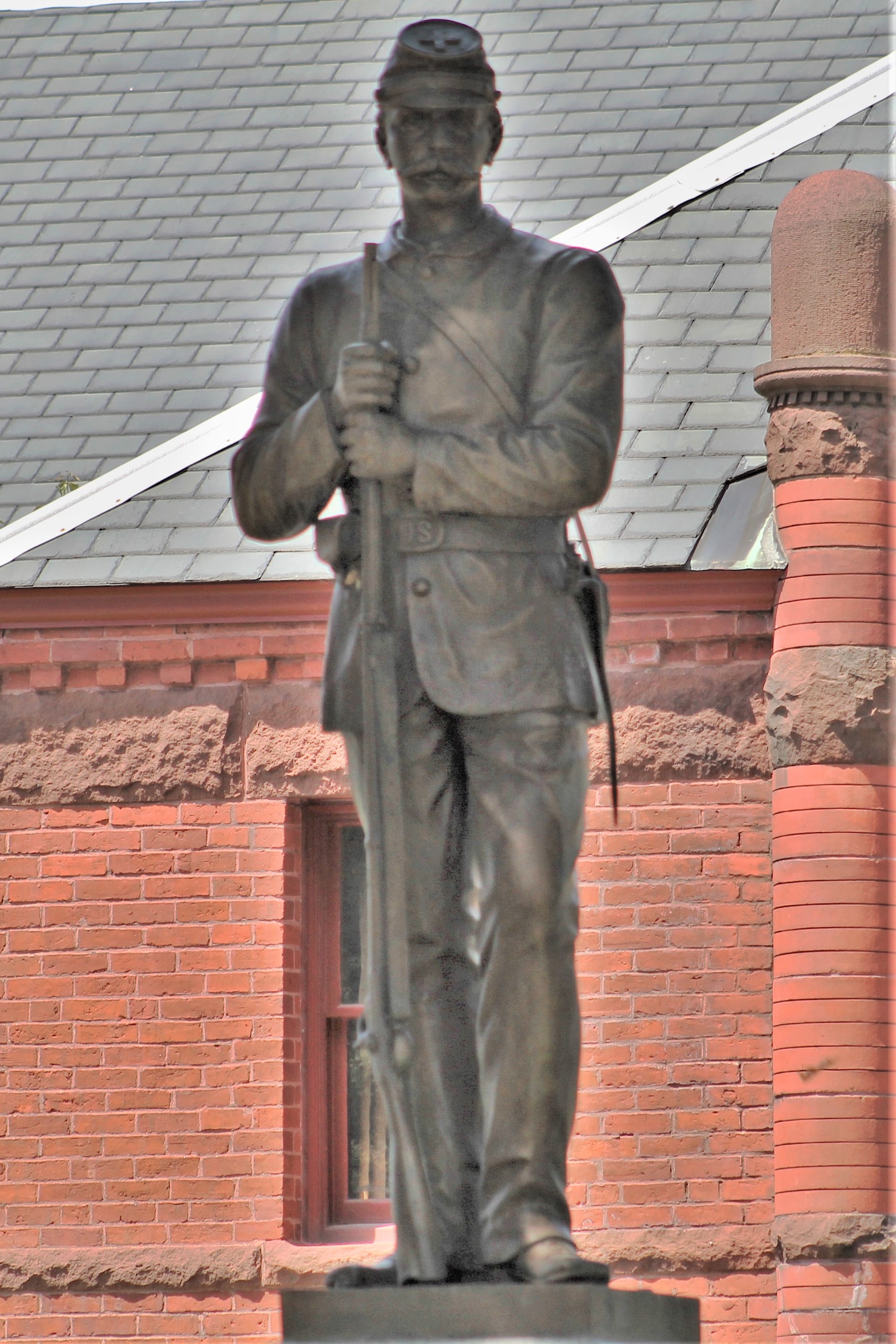
 Location: In front of Goodnow Library, 21 Concord Road, Sudbury
Location: In front of Goodnow Library, 21 Concord Road, Sudbury
Coordinates: 42°21’48.2″N 71°24’58.4″W
Date dedicated: May 31, 1897
Architect/contractor/sculptor: Badger Brothers of Quincy, design and construction; sculptor of statue unknown
Number of names: 11 men who died in the war
Samuel B. Rogers of Sudbury funded this monument. He was born in Waltham but resided in Sudbury most of his life. He made his fortune in transporting hogs from Ohio to Brighton, Massachusetts (known well into the 20th century as Boston’s district for stockyards and slaughterhouses). His enterprise expanded significantly with the construction of railroads. During the war he took an active interest in supporting Sudbury’s soldiers with supplies and even visited them in Gettysburg shortly after the battle. The soldiers referred to him as “Uncle Sam.”[1]
Sudbury’s first and largest group of volunteers to enlist were 23 men belonging to the town’s militia company, the “Wadsworth Rifle Guards” (named after Capt. Samuel Wadsworth who died during the Attack on Sudbury in King Philip’s War). Upon enlistment, the town provided them with a bounty and new uniforms (grey ones–the usual for state militia then). Most communities provided this sort of support to their early volunteers but Sudbury went above and beyond, also providing each man with a revolver and pledging to support their families at the town’s expense during their absence. This group became part of the 13th Massachusetts Infantry which saw heavy fighting with the Army of the Potomac. Remarkably, they all returned but one–although nine were discharged due to illness or wounds.[2]
 The bronze statue appears to represent a member of the 13th Massachusetts as his cap bears a VI Corps badge (to which the 13th Massachusetts belonged). This is unique–no other Massachusetts monument figure wears a corps badge. It is an excellent sculpture, lifelike and highly accurate in uniform and gear. His McDowell style cap is distinctive. It seems to be one of a kind, at least within the Commonwealth. Unfortunately, details are elusive as to the sculptor and foundry. Hopefully additional information will turn up.
The bronze statue appears to represent a member of the 13th Massachusetts as his cap bears a VI Corps badge (to which the 13th Massachusetts belonged). This is unique–no other Massachusetts monument figure wears a corps badge. It is an excellent sculpture, lifelike and highly accurate in uniform and gear. His McDowell style cap is distinctive. It seems to be one of a kind, at least within the Commonwealth. Unfortunately, details are elusive as to the sculptor and foundry. Hopefully additional information will turn up.
During the dedication, John L. Bates gave the oration. He was a prominent state representative and future governor. In summing up why Union men fought, he said, “Theirs was a contest, primarily, to be sure, for the perpetuity of the Union, but behind that and above it was the irrepressible conflict for humanity, for fraternity, a conflict to make the Declaration of Independence a truth and not a lie in this country, a conflict to extend freedom and the right to the pursuit of life and happiness to every human soul.”[3] He referred to these motives as higher than those of the Revolution, indeed he called them “god-like.” Bates was a young boy during the war, so he did not speak from personal experience. It is an interesting commentary on the causes of the war for the 1890s, a decade in which reconciliation was the main theme and slavery frequently ignored or glossed over. Although, admittedly, he did not dwell on the theme for long.
[1] Proceedings at the dedication of the memorial presented to the town of Sudbury, Massachusetts by Mr. Samuel B. Rogers: in honor of the soldiers in the Civil War, (Sudbury: Published by the Town, 1897), 11-12.
[2] Alfred S. Hudson, The History of Sudbury, Massachusetts, 1638-1889, (Sudbury: Sudbury Press, 1889), 537-539.
[3] Proceedings, 33.


